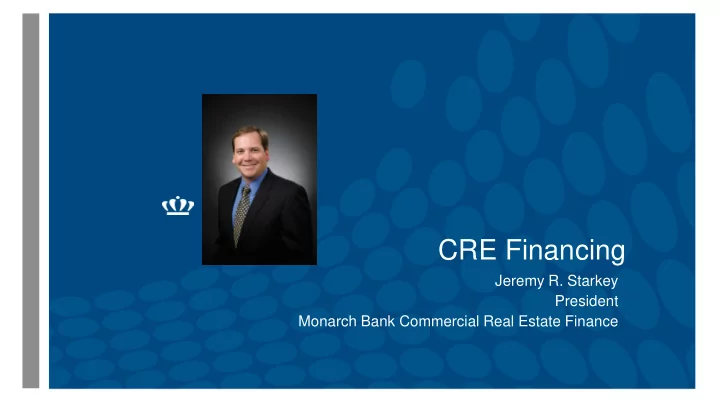

CRE Financing Jeremy R. Starkey President Monarch Bank Commercial Real Estate Finance
CRE Lending Sources Major players are banks, credit unions, capital markets (CMBS & LifeCo), and agencies (multifamily only). Banks are primarily short to intermediate term and generally need recourse, especially during construction/lease-up. Credit unions look for stabilized acquisitions and refinances (no construction or bridge). Capital markets lenders primarily provide long-term, non-recourse debt for stabilized acquisitions and refinances. Agencies operate exclusively in the multifamily lending space.
CRE Lending Sources Major players are banks, credit unions, capital markets (CMBS & LifeCo), and agencies (multifamily only). Banks are primarily short to intermediate term and generally need recourse, especially during construction/lease-up. Credit unions look for stabilized acquisitions and refinances (no construction or bridge). Capital markets lenders primarily provide long-term, non-recourse debt for stabilized acquisitions and refinances. Agencies operate exclusively in the multifamily lending space.
Hampton Roads CRE Lending Banks, especially community banks, lead the way when it comes to providing a consistent and reliable source of capital for deals in Hampton Roads. Major banks, with few exceptions, either have no physical CRE lending presence in the market or have chosen not to focus on CRE lending here. Capital markets lenders typically reduce exposure to secondary and tertiary markets (Hampton Roads) in times of significant volatility or weakness. Existing community banks have healthy balance sheets, local lenders/decision makers, and significant capacity.
Interest Rates/Transaction Volume Global economic weakness, which has led to interest rate volatility and concerns about US economic growth, has tempered the expected 50 bps short-term rate increase in 2016. Short-term rates are not expected to rise materially in the next 12 months. Long-term rates, which most significantly impact CRE deals, have fallen back to the previous historic lows. BUT, spreads have widened out to near unprecedented levels, resulting in a RISE in long-term CRE lending rates. Capital markets lenders react immediately while banks typically lag and, often, don’t react at all. Many of the current wave of CMBS refinances from 10 years ago require additional capital, especially if they were highly-levered and/or full-term I/O when originated. Banks and life insurance companies stand to benefit from much of this refinance volume in 2016 as the CMBS market is currently dysfunctional.
Asset Class Highlights Retail and Multifamily have been the most preferred and the most active asset classes in Hampton Roads. Hospitality construction lending has achieved some traction with major banks competing for the trophy projects. New office construction lending, other than medical office, is largely unavailable without significant preleasing. Industrial lending has been primarily acquisition/refinance driven.
Risk Management Underwriting standards are caught between new regulations and a strong market with financially capable sponsors. Location, experience, and financial capability of the individual sponsor or guarantor is paramount. Community banks like to allocate their capital to relationships vs. transactions. Most lenders have some sort of liquidity and net worth requirement, even for non-recourse deals. Lenders don’t like to finance one’s education in CRE. Regulators are requiring banks to stress-test deals based on rising cap rates and interest rates. Higher risk deals require more capital allocation, which impacts the rate charged to the borrower. Structured reserves are becoming more popular with all sources.
Debt for CRE borrowers in the Hampton Roads market remains highly obtainable for quality deals due to our relatively stable economy and roster of healthy lenders. Low long-term rates will benefit borrowers. CRE Experienced and financially-capable sponsors will thrive. Financing Competition between banks and other Summary lenders will result in aggressive terms for the best projects. Regulatory underwriting and asset class allocation impacts should be monitored.
2016 Hampton Roads Real Estate Market Review & Forecast E.V. Williams Center for Real Estate 2088 Constant Hall Norfolk, VA 23529 www.odu.edu/business/center/creed
Recommend
More recommend